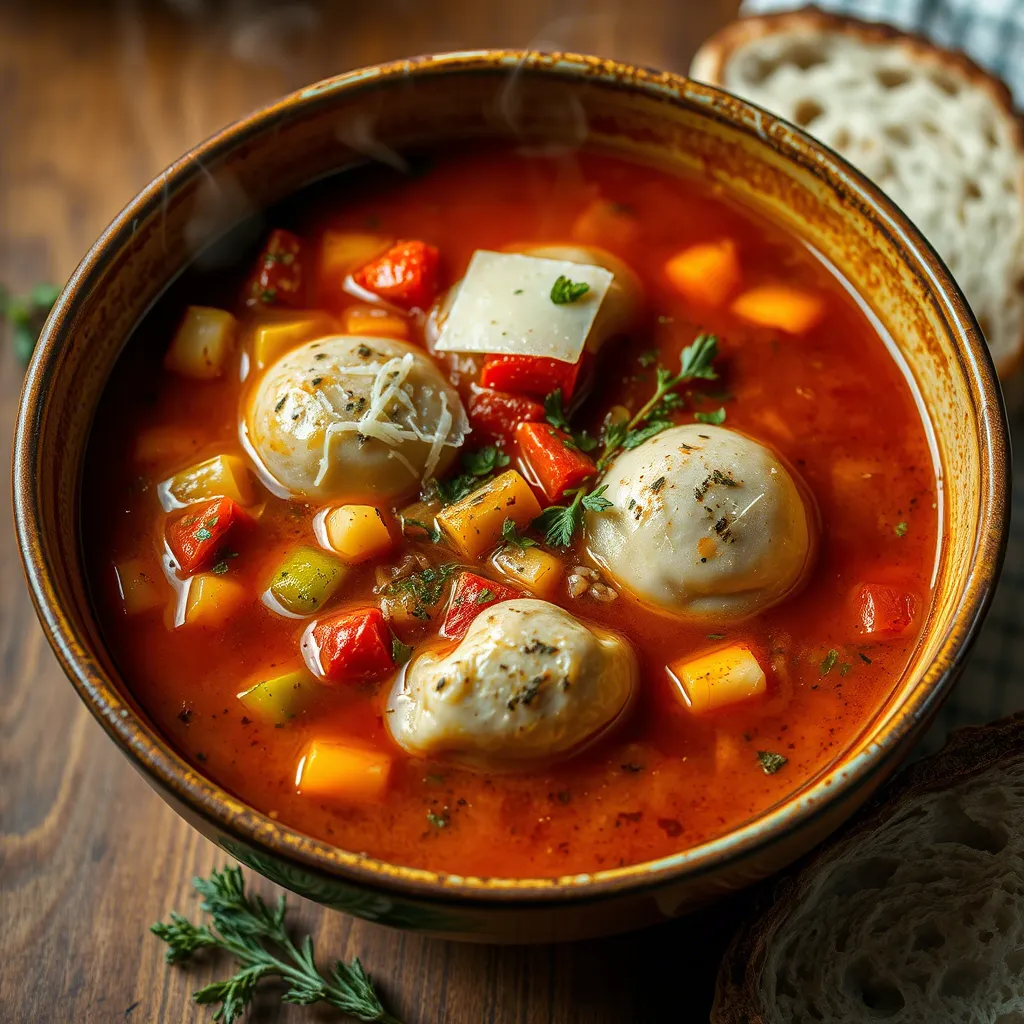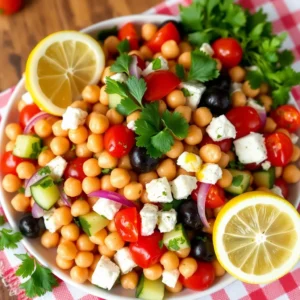Why You’ll Love This Winter Vegetable Minestrone
Picture this: it’s a chilly January evening, the wind is howling outside, and the thought of another takeout meal makes you sigh. We’ve all been there, haven’t we? This vegetable minestrone with pillowy herbed dumplings is about to become your winter kitchen hero, and I’m not even slightly exaggerating.
As a busy parent myself, I understand the evening chaos all too well – homework battles, activity shuttling, and somehow, dinner needs to appear on the table. This soup steps in like that dependable friend who always knows exactly what you need. The beauty of this minestrone lies in its forgiving nature – running late? The soup will happily simmer a bit longer. Got a vegetable drawer full of odds and ends? Toss them in! That slightly wilted celery and the two lonely carrots in your produce drawer are about to be transformed.
What sets this vegetable minestrone apart is the addition of herbed dumplings – little clouds of comfort that take this from “just soup” to “the meal my family requests weekly.” The dumplings soak up all that wonderful broth while adding a satisfying heartiness that means you won’t hear “I’m still hungry” fifteen minutes after dinner.
If you’re trying to incorporate more plant-based meals into your routine (aren’t we all these days?), this soup delivers serious nutrition without wagging a finger at you. It’s packed with vegetables, beans, and herbs that work together to create a flavor that feels like it’s been developing for hours, not minutes.
For my fellow meal-prep enthusiasts, this soup is a dream come true. It actually improves with a day or two in the refrigerator as the flavors meld and deepen. Make a big batch on Sunday, and you’ve got lunch sorted for half the week. Talk about working smarter, not harder in the kitchen!
One of my favorite things about this recipe is watching picky eaters (we all have them) gradually pick around the “suspicious green things” only to eventually ask for seconds. There’s something about the rich tomato broth and those herbed dumplings that wins over even the most vegetable-averse diners.
And let’s be honest – in the current economy, stretching our grocery budget without sacrificing nutrition or flavor is a daily challenge. This vegetable minestrone costs pennies per serving but tastes like a million bucks. If that’s not kitchen magic, I don’t know what is.
When the weather outside is frightful (as my grandmother would say), there’s something deeply satisfying about a pot of soup bubbling on the stove. It’s like an edible version of a warm hug. The aroma alone works better than any fancy candle to make your home feel instantly cozy. Just yesterday, my neighbor dropped by unexpectedly while I had this simmering, and her first words were, “Whatever that is, I need the recipe immediately!”
The Story Behind This Winter Vegetable Minestrone
The first time I made this vegetable minestrone was, like many great culinary adventures, born out of necessity. It was one of those winter days where leaving the house seemed like an Olympic sport – icy sidewalks, biting wind, and a forecast promising more of the same. My pantry was looking rather sparse, and the vegetable drawer contained what can only be described as “the leftovers nobody wanted.”
As I stared at these humble ingredients, I remembered my grandmother’s kitchen wisdom: “With good broth and a little love, anything can become a meal to remember.” She had grown up during times when stretching ingredients wasn’t trendy – it was necessary. Her minestrone never followed a recipe; it followed the seasons and what was available. Some of my fondest childhood memories involve sitting at her kitchen counter, watching her hands move with certainty as she transformed the ordinary into the extraordinary.
I’ve since discovered that the best minestrone recipes are infinitely adaptable – a reflection of the Italian tradition where this soup originated. Minestrone literally means “big soup” in Italian, and historically, it was made with whatever vegetables were in season, often with beans for protein and sometimes with pasta or, as in our case, dumplings for added substance.
My kids, who once approached vegetable-heavy dishes with the suspicion of FBI agents, have gradually become this soup’s biggest champions. My daughter Emma, who at age eight declared green foods “poisonous,” now helps me chop the kale. Small victories, my friends!
What started as a “making do” meal has evolved into our family’s winter tradition. On the first real cold snap of the season, someone inevitably asks, “Is it minestrone weather yet?” The answer is always a resounding yes.
I remember one particularly memorable evening when we lost power during a winter storm. With our electric stove out of commission, we moved the operation to our backyard fire pit, setting our Dutch oven directly on the embers. Huddled around the fire, watching the steam rise from the pot as snowflakes fell around us, that improvised dinner became an adventure we still talk about years later.
There’s something about a bubbling pot of vegetable minestrone that transcends mere sustenance. In our increasingly disconnected world of delivery apps and microwave meals, the act of chopping vegetables, stirring a pot, and breaking bread together (or in this case, enjoying dumplings together) feels almost revolutionary.
I’ve served this soup to neighbors during hard times, to friends celebrating good news, and to my own family on countless ordinary Tuesdays that needed a little brightening. Food has this remarkable ability to comfort, to connect, and to create memories – and this winter vegetable minestrone has done all three in my home.
So whether you’re cooking for a table full of loved ones or just for yourself with a good book for company, I hope this minestrone brings you the same warmth and comfort it has brought to my kitchen. As my grandmother would say, “Food made with love always tastes better.” And this soup? It’s made with love in every single step.
Ingredients
Let’s gather everything we need for this soul-warming vegetable minestrone. One of the beauties of this recipe is its flexibility, so don’t panic if you’re missing something—I’ve included possible substitutions throughout.
For the Minestrone Base:
- 2 tablespoons olive oil (extra virgin gives the best flavor, but regular works too)
- 1 large onion, diced (about 1½ cups—yellow onions provide the best flavor foundation, but red will work in a pinch)
- 3 medium carrots, diced (about 1 cup—those slightly bendy carrots in your crisper drawer? Perfectly fine!)
- 2 celery stalks, diced (about ¾ cup—include the leaves if you have them, they add wonderful flavor)
- 4 garlic cloves, minced (about 1½ tablespoons—jarred works if that’s what you have)
- 1 tablespoon tomato paste (the secret flavor booster—if you don’t have any, you can substitute 2 extra tablespoons of crushed tomatoes)
- 1 teaspoon dried oregano
- 1 teaspoon dried thyme
- ½ teaspoon dried rosemary
- ¼ teaspoon red pepper flakes (adjust to your heat preference)
- 1 bay leaf (don’t skip this! It adds incredible depth)
- 1 can (14.5 oz) crushed tomatoes
- 6 cups vegetable broth (homemade is amazing, but a good quality store-bought works wonderfully)
- 2 medium potatoes, diced (about 2 cups—Yukon golds hold their shape best, but any potato will do)
- 1 can (15 oz) cannellini beans, drained and rinsed (Great Northern or navy beans make good substitutes)
- 1 medium zucchini, diced (about 1½ cups—yellow summer squash works too)
- 2 cups chopped kale, stems removed (swap with spinach or Swiss chard if needed)
- 1 tablespoon lemon juice (the secret brightening ingredient)
- Salt and freshly ground black pepper, to taste
- Freshly grated Parmesan for serving (optional, but highly recommended)
For the Herbed Dumplings:
- 1½ cups all-purpose flour
- 2 teaspoons baking powder
- ½ teaspoon salt
- 3 tablespoons cold unsalted butter, cut into small pieces
- 2 tablespoons fresh parsley, finely chopped (or 2 teaspoons dried)
- 1 tablespoon fresh chives, finely chopped (or 1 teaspoon dried)
- 1 teaspoon fresh thyme leaves (or ¼ teaspoon dried)
- ¾ cup milk (any kind works—I’ve used everything from whole to almond)
- 1 egg, lightly beaten
Now, let’s talk about some key ingredients that make this vegetable minestrone special:
The combination of onion, carrot, and celery (known as “mirepoix” in fancy chef terms) forms the flavor foundation of this soup. Don’t rush this step—allowing these vegetables to cook slowly until they’re soft brings out their natural sweetness.
Cannellini beans aren’t just for protein—they release a gentle starchiness that helps thicken the broth slightly. If you’re a beans-from-scratch person, about 1½ cups of cooked beans equals one can. According to a study from the Harvard School of Public Health, beans are nutritional powerhouses that can help reduce cholesterol and stabilize blood sugar.
For the kale, I prefer Tuscan (also called Lacinato or Dinosaur) kale for its tenderness, but curly kale works wonderfully too. Remove those tough stems—they take much longer to cook and can be bitter.
The herbed dumplings elevate this from everyday soup to something special. The fresh herbs make a world of difference, but dried will absolutely work if that’s what you have on hand. The key is using cold butter and not overmixing the dough, which keeps the dumplings light and fluffy.
Execution
Now let’s walk through making this vegetable minestrone step by step. The process is straightforward, but a few key techniques will ensure your soup has restaurant-quality flavor.
Preparing the Minestrone Base:
- Build the flavor foundation (10 minutes): Heat the olive oil in a large Dutch oven or heavy-bottomed pot over medium heat. Once it’s shimmering (but not smoking), add the diced onion, carrots, and celery along with a pinch of salt. Cook for 8-10 minutes, stirring occasionally, until the vegetables have softened and the onion is translucent. Don’t rush this step—it’s building your flavor base!
- Add aromatics (2 minutes): Add the minced garlic, tomato paste, dried oregano, thyme, rosemary, and red pepper flakes. Stir constantly for about 30-60 seconds until everything is fragrant. You’ll know it’s ready when the tomato paste darkens slightly and the garlic becomes aromatic but not brown. (Burnt garlic is bitter, so watch carefully!)
- Build the broth (5 minutes): Add the crushed tomatoes and bay leaf, then pour in the vegetable broth. Stir well, scraping the bottom of the pot with a wooden spoon to release any browned bits (that’s flavor gold!). Bring the mixture to a gentle boil.
- Cook the potatoes (10 minutes): Add the diced potatoes to the boiling broth, reduce the heat to maintain a simmer, and cook for about 10 minutes or until the potatoes are just barely fork-tender. They’ll continue cooking, so we don’t want them completely soft yet.
- Add remaining vegetables (5 minutes): Stir in the drained and rinsed cannellini beans and diced zucchini. Return to a simmer and cook for about 5 minutes—just enough to take the raw edge off the zucchini while keeping some texture.
While the soup simmers, prepare the dumpling mixture:
- Mix dry ingredients: In a medium bowl, whisk together the flour, baking powder, and salt.
- Cut in butter: Using your fingertips or a pastry cutter, work the cold butter pieces into the flour mixture until it resembles coarse crumbs. Imagine you’re making biscuits—we want little pockets of butter that will create steam and make the dumplings fluffy.
- Add herbs: Gently stir in the chopped fresh herbs, distributing them evenly.
- Combine wet ingredients: In a small bowl, whisk together the milk and beaten egg until well combined.
- Form dumpling dough: Pour the wet ingredients into the flour mixture and stir gently with a fork just until a soft, shaggy dough forms. The key here is to not overmix—a few lumps are perfectly fine! The dough should be sticky but holdable. If it’s too wet, add a tablespoon of flour; if too dry, add a splash of milk.
Finishing the Minestrone:
- Add kale (2 minutes): Stir the chopped kale into the simmering soup. It will look like a lot at first, but it wilts down considerably.
- Drop the dumplings (1 minute): Using a tablespoon or small cookie scoop, drop golf ball-sized portions of the dumpling dough onto the surface of the simmering soup. You should get about 12-14 dumplings. Leave some space between them as they’ll expand during cooking.
- Cook covered (15 minutes): Immediately cover the pot with a tight-fitting lid and reduce the heat to maintain a gentle simmer. Cook undisturbed for 15 minutes. This is crucial—no peeking! The steam trapped inside cooks the dumplings perfectly.
- Check doneness: After 15 minutes, check that the dumplings are cooked through by inserting a toothpick into the center of one—it should come out clean. The dumplings should be light and fluffy on top while the bottoms will have soaked up some of the flavorful broth.
- Final touches: Remove the bay leaf (no one wants to bite into that surprise). Stir in the lemon juice and taste the soup, adjusting the salt and pepper as needed. The lemon juice might seem like a small addition, but it brightens all the flavors and brings everything into balance.
To serve, ladle the hot vegetable minestrone and dumplings into bowls, making sure each serving gets at least one or two dumplings. Sprinkle with freshly grated Parmesan if desired, and serve with a chunk of crusty bread for the ultimate comfort meal. If someone at your table claims not to like vegetables, just wait—this soup has been known to convert even the most dedicated veggie-avoiders!
Additional Tips
Let’s dive into some practical advice to make this vegetable minestrone even more spectacular and adaptable to your specific needs. After all, the best recipes are the ones you can make your own!
Make-Ahead Magic: This soup is the meal-prepper’s dream. The flavors actually improve after a day in the refrigerator as everything melds together. If making ahead, I recommend preparing the soup base completely but stopping before adding the kale or making the dumplings. When you’re ready to serve, reheat the soup, add the kale, and then make fresh dumplings. Fresh dumplings always have the best texture, but if you’re really pressed for time, you can refrigerate the dumpling dough separately for up to 24 hours.
Storage Solutions: Leftover minestrone will keep beautifully in an airtight container in the refrigerator for up to 4 days. The dumplings will absorb more broth as they sit, transforming the leftovers into an almost stew-like consistency. Some people (myself included) actually prefer it this way! If you find it too thick, simply add a splash of broth or water when reheating.
Freezer-Friendly Approach: The soup base freezes exceptionally well for up to 3 months. Again, freeze it before adding the kale or dumplings. Defrost overnight in the refrigerator, then reheat, add fresh kale, and make fresh dumplings. If you’re preparing this specifically for freezing, slightly undercook the vegetables as they’ll soften more during reheating.
Seasonal Variations: This vegetable minestrone adapts beautifully to whatever the seasons offer:
- Spring Version: Swap potatoes for new potatoes, add fresh peas, asparagus tips, and tender young spinach
- Summer Version: Use yellow squash, fresh corn kernels, green beans, and fresh tomatoes instead of canned
- Fall Version: Add diced butternut squash, parsnips, and a pinch of nutmeg
- Deep Winter Version (as written): Hearty root vegetables, kale, and those comforting dumplings
Dietary Adaptations:
- Gluten-Free: Replace the all-purpose flour in the dumplings with a 1-to-1 gluten-free flour blend. Add ¼ teaspoon of xanthan gum if your blend doesn’t include it for better texture.
- Dairy-Free: Substitute the butter in the dumplings with cold coconut oil and use unsweetened almond or oat milk.
- Vegan: In addition to the dairy substitutions above, replace the egg with a flax egg (1 tablespoon ground flaxseed mixed with 3 tablespoons water, let sit for 5 minutes until gelatinous).
- Higher Protein: Add a second can of beans or 2 cups of shredded rotisserie chicken added with the kale.
Troubleshooting Common Issues:
- Watery Soup: If your broth lacks body, mash about ¼ cup of the cannellini beans before adding them to the soup. The bean starch will naturally thicken the broth.
- Dumpling Disasters: If your dumplings fall apart, the most common culprit is too much stirring of the dough (which develops gluten and toughens them) or lifting the lid while they cook (which releases the steam they need).
- Bitter Broth: Sometimes kale can impart bitterness. Make sure to remove all the tough stems and massage the leaves briefly before chopping. The lemon juice at the end also helps balance any bitter notes.
Kitchen Equipment Notes: While you don’t need fancy equipment to make this minestrone, a heavy-bottomed Dutch oven or soup pot makes a difference by distributing heat evenly. If you don’t have one, any large pot will work—just stir more frequently to prevent hot spots. A sharp knife makes vegetable prep much quicker and safer. There’s truth to the old saying that dull knives cause more injuries than sharp ones!
Garnish Ideas to Elevate Your Bowl:
- A drizzle of high-quality extra virgin olive oil
- Freshly grated Parmesan or aged Pecorino
- Toasted pine nuts or pumpkin seeds for crunch
- A small dollop of pesto (store-bought is fine!)
- Fresh herbs like basil or parsley
Time-Saving Shortcuts: On especially busy days, consider these shortcuts:
- Use pre-chopped mirepoix mix from the produce section
- Substitute baby spinach for kale (no stem removal needed)
- Use frozen diced vegetables (add them directly from frozen)
- Try store-bought gnocchi instead of making dumplings from scratch
According to the Culinary Institute of America, the key to exceptional soup isn’t fancy ingredients but proper layering of flavors and understanding how ingredients release their essence at different cooking stages. This vegetable minestrone embodies that principle perfectly.
FAQs
Can I make this vegetable minestrone in a slow cooker?
Absolutely! This recipe adapts beautifully to a slow cooker. Follow steps 1-2 in a skillet first (building that flavor base is essential), then transfer everything to your slow cooker along with the broth, tomatoes, potatoes, and beans. Cook on low for 6-7 hours or high for 3-4 hours. Add the zucchini during the last hour, and the kale during the last 30 minutes. For the dumplings, increase the slow cooker to high, drop the dumplings on top, cover and cook for about 30 minutes until they’re cooked through.
How can I make this soup heartier for my meat-loving family?
This winter soup is quite hearty on its own, but for dedicated carnivores, you have several options. Brown 8 ounces of Italian sausage (casings removed) or pancetta before adding the mirepoix. For a lighter touch, shredded rotisserie chicken or diced ham added near the end of cooking works beautifully. The herbed dumplings already add significant heartiness, but you could also stir in some cooked pastina or small shell pasta if you prefer.
My dumplings turned out dense rather than fluffy. What went wrong?
The two most common dumpling pitfalls are overmixing the dough and removing the lid during cooking. For light, fluffy dumplings, mix the dough just until the ingredients come together—it should look somewhat lumpy. Cold ingredients are also crucial; warm butter won’t create the steam pockets needed for fluffiness. Finally, once you drop the dumplings into the simmering soup, cover immediately with a tight-fitting lid and don’t peek for the full 15 minutes. The trapped steam is essential for proper dumpling texture.
Can I use different beans in this minestrone?
Definitely! While cannellini beans provide a creamy texture that works wonderfully in this comfort food recipe, you can substitute any white bean (navy, Great Northern) or even kidney beans, chickpeas, or borlotti beans. For extra flavor dimension, use a mixture of two different bean varieties. Remember that if you’re using dried beans, they’ll need to be cooked separately before adding to the soup.
How do I adjust the consistency of the soup?
This vegetable minestrone naturally has a medium broth consistency—not too thin, not too thick. If you prefer a thicker soup, you have several options: mash some of the beans or potatoes against the side of the pot, sprinkle in 1 tablespoon of cornstarch mixed with 2 tablespoons cold water, or add a Parmesan rind while the soup simmers (remove before serving). For a thinner soup, simply add more broth or water and adjust the seasonings accordingly.
Is there a way to reduce the prep time for weeknight cooking?
This soup is perfect for batch cooking on weekends! For quicker weeknight assembly, prep all vegetables in advance and store them in airtight containers. You can even assemble the dumpling dry ingredients and store them in a jar—just add the wet ingredients when you’re ready to cook. Another time-saving trick is to use frozen vegetables, which work perfectly in this forgiving recipe.
Why did you add lemon juice at the end?
The small amount of acid from the lemon juice might seem insignificant, but it’s actually a chef’s secret weapon! Acid brightens flavors, balances the richness of the broth, and cuts through any potential bitterness from the kale or other vegetables. If you don’t have lemon juice, a splash of white wine vinegar or even balsamic vinegar works wonderfully too. This small addition makes a surprisingly big difference in the final taste.
As with any treasured recipe, the real joy of this vegetable minestrone comes not just from following instructions, but from making it your own. Each time you prepare it, you might discover a new variation, ingredient combination, or serving method that perfectly suits your family’s tastes. The most beloved family recipes evolve this way—through gentle tweaking and personalization over many meals shared together.
The beauty of comfort food lies not just in its ability to nourish our bodies but in how it gathers people around the table. This vegetable minestrone with its pillowy herbed dumplings has that magical quality of turning an ordinary weeknight into something special—a moment to pause, connect, and enjoy the simple pleasure of a homemade meal.
So ladle it up, pass the Parmesan, and watch as conversation flows as warm and comforting as the steam rising from those soup bowls. In our busy, sometimes disconnected lives, these shared meals become the threads that weave our family stories together. And sometimes, those stories begin with something as humble as a pot of soup on a cold winter’s evening.



